

Biodegradable Plastics: True or False? Good or Bad? By Brenda Platt Coordinator, Sustainable Plastics Project, Institute for Local Self-Reliance In an attempt to position their products as green, several companies have recently introduced biodegradable products made from conventional plastics.
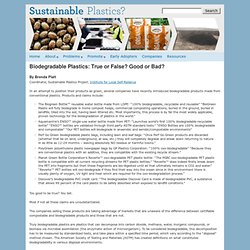
Products and claims include: The Biogreen Bottle™ reusable water bottle made from LDPE: “100% biodegradable, recyclable and reusable” “BioGreen Plastic will fully biodegrade in home compost heaps, commercial composting operations, buried in the ground, buried in landfills, tilled into the soil, having been littered etc. Most importantly, this process is by far the most widely applicable, proven technology for the biodegradation of plastics in the world.”Aquamantra’s ENSO™ single-use water bottle made from PET: “Launches world’s first 100% biodegradable-recyclable bottle” “ENSO™ bottles are validated through third party ASTM standard tests.”
Too good to be true? Biodegradable Plastics: True or False? Good or Bad? Sustainably printed stickers on 100% recycled paper. Soy inks. Green certified SF Bay Area business. This privacy notice discloses the privacy practices for www.greenerprinter.com.
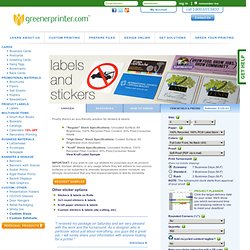
This privacy notice applies solely to information collected by this web site. It will notify you of the following: What personally identifiable information is collected from you through the web site and how it is used and with whom it may be shared. What choices are available to you regarding the use of your data. The security procedures in place to protect the misuse of your information. Information Collection, Use, and Sharing We are the sole owners of the information collected on this site. We will use your information to respond to you, regarding the reason you contacted us.
Unless you ask us not to, we may contact you via email in the future to tell you about specials, new products or services, or changes to this privacy policy. Your Access to and Control Over Information. Cardboard Waste Tower - Viewing All Comments. I made this when I moved into my dorm room at college and got fed up having such a messy trash and recycling situation.
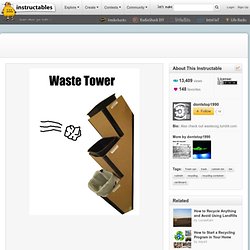
I designed something to elegantly separate trash from paper recycling and plastic/metal recycling. Having just moved to New York City, I was inspired by the efficiency of building upward. So I decided to make the Waste Tower... I designed the Waste Tower to hold standard size office waste bins. This is one of those projects that are pretty self explanatory. Samira Khoshnood. June 24, 2010 | 15 Comments Designed by Samira Khoshnood | Country: United States “Identity and package design for Meringue, an upscale dessert boutique, seeking to capture the airy whipped quality of meringue, the main ingredient in most of the store’s pastries.
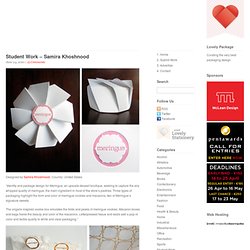
Three types of packaging highlight the form and color of meringue cookies and macarons, two of Meringue’s signature sweets. The origami-inspired cookie box emulates the folds and peaks of meringue cookies. Student Work - Gerlinde Gruber. February 11, 2010 | 12 Comments Designed by Gerlinde Gruber | Country: Austria Thanks to Gerlinde for sending in her very lovely conceptual design for jewelry packaging. We’re loving the approach. The paper sleeve offers excellent opportunities for branding and labeling, and the size of the box creates a larger, more substantial product out of a small piece of jewelry. Packaging Europe - World of European Packaging. Mattel Sets Sustainable Packaging Goals After Greenpeace Pressure. Mattel unveiled a new paper and wood fiber sourcing policy today, months after a Greenpeace campaign highlighted Mattel's ties to a controversial supplier.
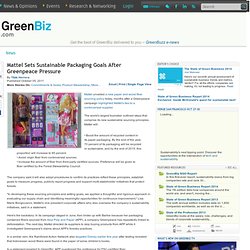
The world's largest toymaker outlined steps that comprise its new sustainable sourcing principles. Mattel will: • Boost the amount of recycled content in its paper packaging. By the end of the year, 70 percent of its packaging will be recycled or sustainable, and by the end of 2015, this proportion will increase to 85 percent. • Avoid virgin fiber from controversial sources. • Increase the amount of fiber from third-party certified sources. Preference will be given to fiber certified by the Forest Stewardship Council. The company said it will also adopt procedures to confirm its practices reflect these principles, establish goals to measure progress, publicly report progress and support multi-stakeholder initiatives that protect forests.
How to Convince Companies that Wasting Their Waste is Wasteful. [Editor's Note: This is the first post in an ongoing series from Albe Zakes, the Global Vice President of Media Relations at TerraCycle; he is kicking off the series with an overview of how the company creates and continues its relationships to turn trash into new products.]
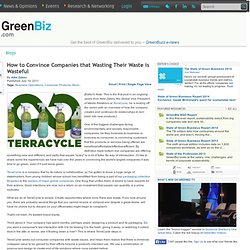
One of the biggest challenges facing environmentally and socially responsible companies, be they business-to-business or business-to-consumer, is convincing customers that the products or services being offered are beneficial/affordable/effective/efficient. By definition triple bottom line companies are offering something new and different, and sadly that equals "scary" to a lot of folks. By way of introduction, I'd like to share some the experiences we have had over the years in convincing the world's largest companies it was time to go green, even if it cost some green. What we do at TerraCycle is simple: Create opportunities where once there was waste.